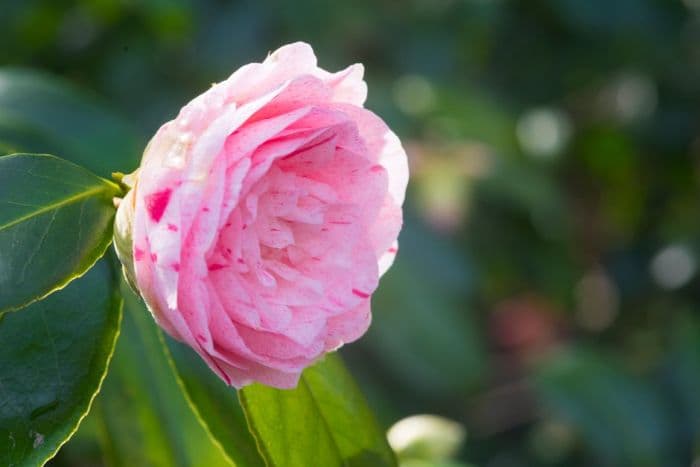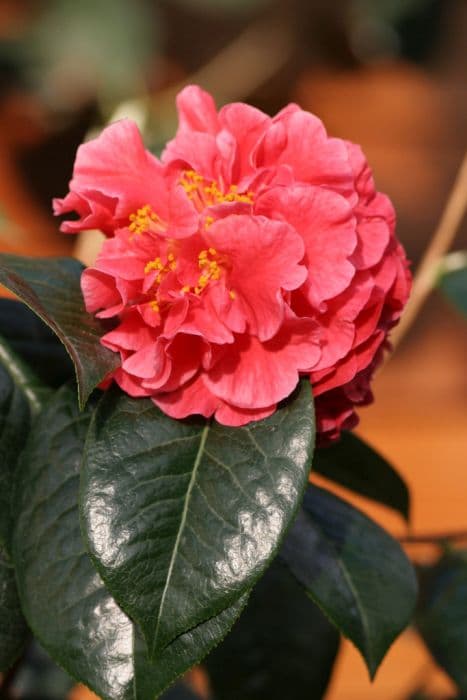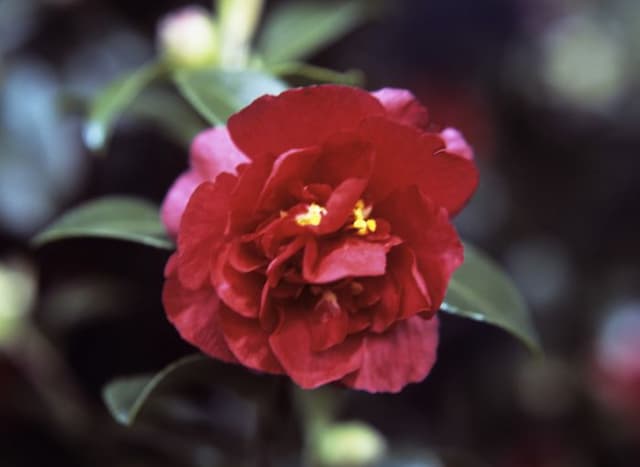Williamsii Camellia Camellia × williamsii 'Hilo'

ABOUT
Camellia 'Hilo' is an ornamental flowering shrub known for its outstanding beauty and grace. Its glossy, evergreen leaves present a dark green hue, providing a lustrous backdrop for its exquisite blooms. The flowers of 'Hilo' are particularly captivating, displaying a splendid palette of pinks, which can range from soft blushes to deeper shades, depending on the particular variety. The blossoms exhibit an elegant form, typically being large with a rounded shape, and their petals are often delicately arranged in overlapping whorls that impart a sense of softness and depth. The petals might exhibit a slight ruffling at the edges, adding to the overall romantic impression of the bloom. At the center of each flower, a cluster of contrasting golden stamens makes a striking statement, attracting pollinators and admirers alike. The plant's overall appearance is one of classic charm and has a refined presence in any garden setting where it's grown. Its aesthetic appeal is matched by the reliability and resilience that it brings to landscapes, offering a pleasing display over a long period when the conditions are favorable for its growth.
About this plant
 Names
NamesFamily
Theaceae.
Synonyms
Williams' Camellia, Hilo Camellia.
Common names
Camellia × williamsii 'Hilo'.
 Toxicity
ToxicityTo humans
The Camellia × williamsii 'Hilo', commonly known as camellia, is generally considered to be non-toxic to humans. There are no well-documented cases of poisoning from ingesting camellia plants, and they are not known to contain toxic substances that would cause harm to people. Therefore, accidental ingestion of parts of this plant typically does not lead to any severe symptoms or consequences.
To pets
Camellia × williamsii 'Hilo', commonly referred to as camellia, is not known to be toxic to pets such as dogs and cats. This plant is not listed on toxic plant databases for pets, and ingestion is unlikely to cause serious illness or poisoning. However, as with any non-food plant, excessive consumption might result in mild gastrointestinal upset in some pets, due to the ingestion of plant material that is not part of their usual diet. Generally, though, camellias are considered safe around pets.
 Characteristics
CharacteristicsLife cycle
Perennials
Foliage type
Evergreen
Color of leaves
Green
Flower color
Pink
Height
6-10 feet (1.8-3 meters)
Spread
5-8 feet (1.5-2.4 meters)
Plant type
Shrub
Hardiness zones
7
Native area
Japan China
Benefits
 General Benefits
General Benefits- Aesthetic Appeal: Produces attractive flowers that enhance garden beauty and create visual interest.
- Landscape Versatility: Can be used as a specimen plant, in borders, or as part of a mixed shrubbery providing structure and form to gardens.
- Seasonal Interest: Blooms typically in late winter to spring, offering color during a time when few other plants are flowering.
- Wildlife Attraction: Flowers can attract pollinators such as bees, and the dense foliage provides shelter for birds.
- Low Maintenance: Once established, it generally requires minimal care beyond occasional pruning and watering during dry periods.
- Drought Tolerance: Has the ability to withstand periods of dry weather once fully established, reducing the need for frequent watering.
 Medical Properties
Medical PropertiesThis plant is not used for medical purposes.
 Air-purifying Qualities
Air-purifying QualitiesThis plant is not specifically known for air purifying qualities.
 Other Uses
Other Uses- Camellia × williamsii 'Hilo', commonly known as Camellia, can be used in floral arrangements as the blossoms are quite showy and long-lasting when cut.
- The glossy, evergreen leaves of Camellia can be used in garlands or wreaths, providing a sturdy and rich green backdrop for other decorative elements.
- The dense growth habit of Camellia makes it a suitable choice for creating privacy hedges or screens in gardens.
- Camellia wood, being hard and dense, is sometimes used in the production of small items like handles for tools or cutlery.
- The petals of Camellia flowers can be scattered in baths as a natural and fragrant bath soak.
- The fallen Camellia petals can serve as a natural mulch for garden beds, slowly decomposing and enriching the soil.
- Camellia can be used for bonsai, due to its beautiful flowers, attractive foliage, and the ability to shape its growth.
- In artistic representations, such as paintings or photography, Camellia adds a touch of elegance and can symbolize love and adoration in various cultures.
- The plant's leaves can be used as a natural polish for wooden surfaces, utilizing the oils released from the leaves to impart a shine.
- During certain festivals or celebrations, Camellia flowers are used as decorations or given as gifts to convey good wishes.
Interesting Facts
 Feng Shui
Feng ShuiThe Camellia is not used in Feng Shui practice.
 Zodiac Sign Compitability
Zodiac Sign CompitabilityThe Camellia is not used in astrology practice.
 Plant Symbolism
Plant Symbolism- Adoration: Camellia flowers in general are often associated with adoration and deep longing, due in part to their lavish and beautifully layered petals.
- Perfection: Because of its flawless form and beauty, the camellia can symbolize the ideal of perfection or an unimpeachable standard.
- Longevity and Faithfulness: Camellias are known for their ability to live a long time—as much as 100 to 200 years. This attribute can symbolize a wish for a long and faithful life or relationship.
- Love: The camellia can signify love, especially the red varieties, which often are associated with romantic and passionate love.
- Refinement: The refined nature of the camellia blossom has led to its representation of refinement, elegance, and sophistication in symbolic language.
 Water
WaterThe Williamsii Camellia should be watered deeply to ensure the soil is moist but not soggy, typically once a week depending on weather conditions. During the growing season and in drier weather, it may require more frequent watering, possibly twice a week. It's important to water the plant with about 1-1.5 gallons of water each time to ensure the root zone is thoroughly saturated. Reduce watering in the winter when the plant is not actively growing, but do not allow the soil to completely dry out.
 Light
LightFor the Williamsii Camellia, the ideal light condition is partial shade with some morning sunlight and protection from the hot afternoon sun. The best spot would be in a location where the plant is sheltered from intense midday rays while still receiving sufficient light to encourage healthy growth.
 Temperature
TemperatureThe Williamsii Camellia thrives in temperatures between 60°F and 80°F, which are ideal for growth and flowering. It can survive temporary dips down to around 20°F but should be protected from prolonged exposure to freezing temperatures. Avoid placing the camellia in locations where it could be subjected to extremely hot temperatures, as this can stress the plant.
 Pruning
PruningPrune the Williamsii Camellia to maintain its shape and encourage more vigorous growth. Pruning should be done immediately after the blooming season ends, typically in spring, to avoid cutting off next year's buds. Remove any dead or weak branches, and lightly shape the plant as desired to promote a healthier, more aesthetically pleasing structure.
 Cleaning
CleaningAs needed
 Soil
SoilWilliamsii Camellia thrives in well-draining, acidic soil with a pH of 5.5 to 6.5. The best soil mix can be created using 50% well-rotted leaf mold or peat moss and 50% horticultural sand or perlite to improve drainage.
 Repotting
RepottingWilliamsii Camellias generally need repotting every 2 to 3 years. It's best to repot in the spring but after the flowering season, using an acidic compost and a pot only slightly larger than the previous one.
 Humidity & Misting
Humidity & MistingWilliamsii Camellia prefers high humidity levels, ideally around 50-60%. They thrive in a moist environment, which can be enhanced by placing the pot on a tray filled with pebbles and water.
 Suitable locations
Suitable locationsIndoor
Place near a window for indirect light, keep soil moist, and maintain high humidity.
Outdoor
Plant in partial shade, in acidic, well-drained soil, shelter from strong winds.
Hardiness zone
7-9 USDA
 Life cycle
Life cycleThe Camellia × williamsii 'Hilo' begins its life cycle when a seed germinates, usually in early spring, developing a root system and a shoot that grows upward. As a seedling, it develops true leaves and gradually matures into a small shrub over several years. Once mature, typically after a few years, it begins to flower, usually from late winter to early spring, showing off its colorful blossoms that attract pollinators. After pollination, the flowers produce seed pods that eventually release seeds, completing the reproductive cycle. Throughout its life, which can be quite long—camellias can live for decades—the plant goes through cycles of growth, flowering, and dormancy, typically with a period of dormancy in the winter. With appropriate care, including adequate sunlight, proper watering, and pruning, Camellia × williamsii 'Hilo' continues to grow and bloom annually.
 Propogation
PropogationPropogation time
Spring-Early Summer
The Camellia × williamsii 'Hilo', commonly known as a Camellia, can be propagated through semi-hardwood cuttings, typically taken during late summer or early fall when the plant's new growth has started to mature and harden slightly. The most popular method of propagation for Camellias involves taking semi-hardwood cuttings of about 4 to 6 inches in length. Leaves on the lower half of the cutting should be removed, and the cut end can be dipped into a rooting hormone to enhance root development. The cutting is then planted in a pot filled with a well-draining potting mix, such as a mixture of peat and perlite. To maintain high humidity, which is crucial for rooting success, a plastic bag can be placed over the pot or the pot can be kept in a propagator. The cutting should be kept in a warm, shaded place until roots have developed, which can take several weeks to a few months. It's important to avoid direct sunlight and to ensure the potting medium remains moist but not waterlogged throughout the rooting process.









